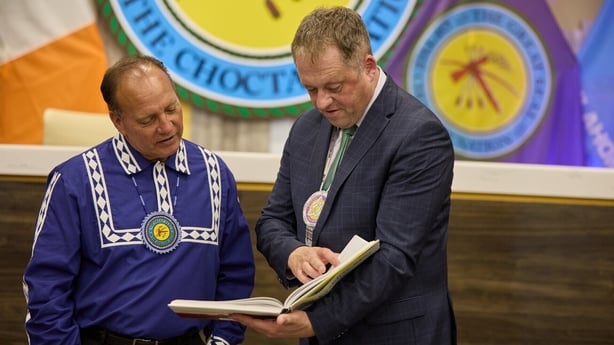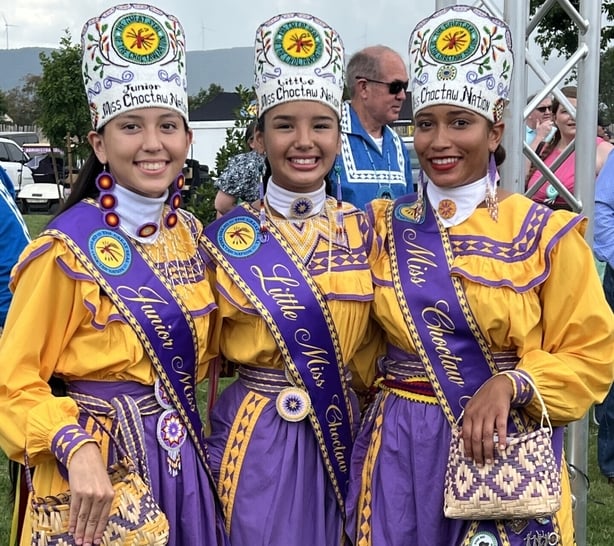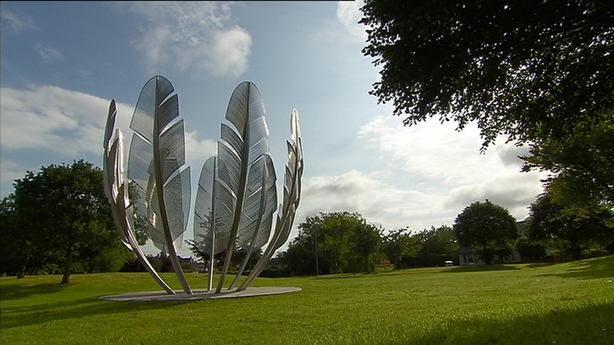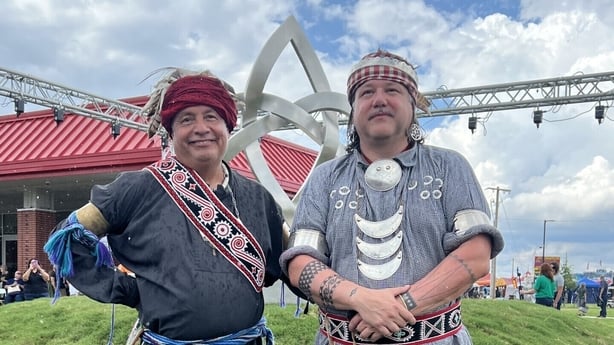Choctaw tribal members, tribal leaders and dignitaries from Oklahoma and Ireland have gathered at the Choctaw Capitol Grounds in Tuskahoma, Oklahoma, to unveil a new sculpture honouring the Choctaw-Irish connection.
The connection was founded on The Gift, a donation of money by the Choctaw Indians for famine relief in Ireland in 1847.
The sculpture, called Eternal Hearts, was a joint commission that was funded by the Government and the Chahta Foundation.
It is a companion piece to Kindred Spirits, a sculpture in Midleton, Co Cork, that was dedicated in 2017 to honour the story of The Gift in Ireland.
We need your consent to load this rte-player contentWe use rte-player to manage extra content that can set cookies on your device and collect data about your activity. Please review their details and accept them to load the content.Manage Preferences
The new 2.45 metre-tall sculpture was built by Choctaw Nation tribal member Samuel Stitt and combines a Celtic trinity shape intertwined with a heart and is specifically placed facing toward Ireland.
"There is no beginning or end to the overall piece - thus, it is eternal," Mr Stitt said.
The aid money collected in 1847 - which ended up being used for famine relief in Midleton - was collected by members of the Choctaw Tribe.
The tribe had just a few years beforehand experienced The Trail of Tears, which involved their removal from ancestral lands in Alabama, Arkansas, Mississippi and Louisiana in the 1830s and their movement to a reservation in what is now the state of Oklahoma.
Living in dire conditions themselves, the Choctaws collected $170 (equivalent today to more than $5,000 or €4,000), after hearing about the Irish famine from a visiting US government official.

During a ceremony in the council chamber in Tuskahoma, Choctaw Nation Chief Gary Batton said: "We are grateful for the giving hearts of our Choctaw ancestors that brought us here today.
"We are excited to see what this eternal bond will bring to future generations of Choctaw and Irish and we are extremely proud to call the people of Ireland our friends and kindred spirits."
The Government was represented by Minister of State Thomas Byrne, who said: "This memorial will be a permanent symbol of the enduring and meaningful friendship between our two nations, a relationship which began with an act of solidarity and extraordinary generosity during the darkest years of the Great Irish Famine."
Speaking to RTÉ News after the ceremony, Minister Byrne said: "It's very emotional for me, and I have to say, quite a number of the Choctaw people that I met were crying or were emotional themselves.
"It is a wonderful connection, the example of generosity in a time of adversity, adversity for us, but also for the Choctaw at the time.
"I think it's a wonderful lesson for anybody."
He said that it is "very important that as the Irish Government, as people of Ireland, that we reach out, we make these connections".
"We remember things that have been done for us," he said.
"And in that spirit, I suppose Ireland should then be a force for good around the world in diplomatic terms, which we tried to be," he added.
Mr Byrne described the events as "really, really important".
"They solidify who we are as a people, what has brought us to this place that we are today and the generosity of the Choctaw certainly plays a role in that story," he said.

He said that the "story of the generosity" of the Choctaw is "something that people are just really enthralled about".
"It was wonderful to see representatives and (State) Senators here today," he added.
He said it was an "important day" for Ireland in Oklahoma, adding that the it outlines the "importance of remembering these type of events in our past and making these connections and showing the example that can flow from the generosity that the Choctaw have shown".
Chief Batton said there was a "full circle" from the famine relief donation by the Choctaw in 1847 to a 2020 aid grant of €2 million from Ireland for Covid-19 relief among Native American tribes, which were severely impacted by the crisis.
Mr Batton said: "Within the nation, our Choctaw Nation, people know the story.
"But outside of that, it's really not that well known.
"And that's the reason why we do the dedication of the sculpture of the Eternal Heart today - to make sure that we don't forget the path that our ancestors put us on, setting the values of caring, of giving, to make sure that we give to other human beings.
"That's who we are as Choctaw people and then also to solidify our strength and resiliency with the people of Ireland, with the compassion that we have for one another."

Sculptor Stitt said it is "a great honour to have a hand in exemplifying the Choctaw-Irish connection through my art".
"The Choctaw culture of giving and caring for others is passed down to each generation," he said.
"The Eternal Heart is an artistic interpretation of how the Irish people and Choctaw Nation will forever be connected by that human characteristic of compassion - one people for another," he added.
Mr Stitt, a former US soldier, said he was inspired to create the sculpture after a visit to Midleton to see the Kindred Spirits piece by artist Alex Pentek.
"I saw the sculpture in Ireland years ago and it was very striking," he said.
"But I thought to myself, ‘so that's in Ireland - we should have a companion piece in Choctaw Nation in Oklahoma,'" he added.
Mr Stitt and his wife worked on various ideas for a couple of years before a call went out for ideas for a commission, so he had a head start in the process.
"So, I was thinking about ideas, if we were to do that, how cool would it be? Maybe we could do more of the motif on the Irish or the Celtic side because the sculpture in Ireland, I would say it's more of a nod to the native motif," he said.
"It's feathers in the shape of a basket," he added.

Mr Stitt said this prompted him to think "if we did a piece on our side, it should be more on the Celtic side".
"I came up with the idea to do this Celtic knot work with the heart inside - the giving heart - and there's no beginning and end, so it's eternal," he said.
He said: "But then I wanted to incorporate Choctaw designs and southeast Native American elements.
"So, the sculpture itself is sitting on a southeast ceremonial earthen mound and then it sits atop a concrete platform, and it's got the Choctaw diamonds around the side because Choctaws love diamonds (the shape, not the stones).
"We put diamonds on everything. But there's 12 diamonds around the perimeter that represent the 12 districts in the Choctaw Nation and also, there's 12 pillars on this new council house, so all of the elements tie in."
He added that the plane of the sculpture "is facing due east to the sunrise and, then generally, to Ireland".
The piece was installed earlier this week to coincide with the Choctaws annual Labour Day celebration, a major gathering of the tribe members at their capital centre in Tuskahoma.

A few finishing touches still have to be applied to the sculpture.
"We have a few elements that we have to finish up on the piece," Mr Stitt said.
"So on the top of the concrete, the platform, we're going to do exposed aggregate, but we're going to embed an arrow pointing to Dublin, the exact orientation with the miles and the kilometres," he said.
Asked about what he hopes people will take from the sculpture, Mr Stitt said: "Well, I actually hope that it becomes a point of pilgrimage because I've noticed with social media, people travel, and they post pictures of where they've been.
"I'm just amazed at how many tribal members go to Ireland specifically to see the Kindred Spirit and they'll post their beautiful photos.
"So, I'm really hoping that this becomes a pilgrimage location on our side and then maybe folks can learn about the story (The Gift) and then more about our tribe and on a larger scale, the Native Americans."
The Choctaw Nation is the third largest Native American Nation in the United States, with almost 230,000 tribal members, most of whom live in Oklahoma.
The Choctaw claim an oral tradition going back some 13,000 years.
They were the first tribe from the southeastern United States to undergo the Trail of Tears, the effective ethnic cleansing of Native Americans from their traditional lands in the southeastern US to then unclaimed territory west of the Mississippi River.
Their reservation land in southeastern Oklahoma covers some 28,231sq/km.






